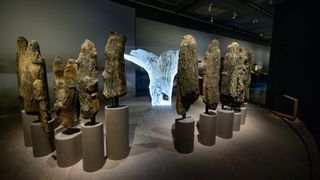A mysterious Bronze Age wooden circle known as “Seahenge” on England’s east coast was built more than 4,000 years ago in an effort to bring back warmer weather during an extreme cold spell, a new study suggests.
The theory is a new attempt to explain the buried structure — a rough circle about 25 feet (7.5 meters) across, made from 55 split oak trunks surrounding a “horseshoe” of five larger oak posts around a large inverted oak stump — that was controversially dug up and moved into a museum in 1999.
Other researchers have suggested it was built to commemorate an important individual who had died, or that it was a place for “sky burials,” where the dead would be pecked by carrion-eating birds.
But the idea that Seahenge and another circle of buried timbers found beside it were built to “extend summer” fits with what’s known about the climate at the time, said David Nance, an archaeologist at the University of Aberdeen in the United Kingdom and the author of the new study.
Related: ‘Major lunar standstill’ may reveal if Stonehenge is aligned with the moon
The construction took place during “a prolonged period of decreased atmospheric temperatures and severe winters and in late springs placing these early coastal societies under stress,” he said in a statement. “It seems most likely that these monuments had the common intention to end this existential threat.”
Nance detailed his study of the two Seahenge structures — known formally as Holme I and Holme II — in a research paper published April 2 in GeoJournal.
Ancient timbers
Nance said dating with dendrochronology — a technique that studies the annual growth rings of trees still visible in ancient timbers — showed that both Seahenge circles were built from trees felled in the spring of 2049 B.C.
He noted that the horseshoe of five larger posts inside the main Seahenge circle seems to have been aligned with sunrise on the summer solstice. It may have mimicked a cage for a young cuckoo, designed to extend summer by keeping the bird singing — a belief described in ancient folklore, he suggested.

Nance explained that the cuckoo — a symbol of fertility to the ancient Britons — was believed to stop singing on the summer solstice and to return to the “Otherworld,” taking the warm summer weather with it.
He proposed that Seahenge and the second wooden circle built beside it were used for different rituals, but with the same intent: “to end the severely cold weather.”
Seahenge gained national attention in late 1998 when erosion at the site near the village of Holme-next-to-the-Sea exposed its timbers and central tree stump. However, local people had known about it for many years.
The structure got its name from British newspapers, which likened it to the famous Stonehenge monument in Wiltshire that many archaeologists now think was a Neolithic ceremonial center and burial ground.
Controversial excavation
In the 1990s, Seahenge occupied a salt marsh near the beach, which was protected from the sea by sand dunes and mudflats. Authorities were concerned that further erosion at the site would destroy the wooden monument, so it was completely excavated in 1999.
But the excavation was controversial because many people thought the monument should have stayed in place, and questions have been raised about the role of the archaeological television show “Time Team,” which featured the excavations in a special episode.
Partly as a result of that controversy, the ancient wooden circle built next to Seahenge — Holme II — has been left in place near the beach and is being monitored for erosion.
Archaeologist Brian Fagan, a professor emeritus at the University of California, Santa Barbara who wasn’t involved in the latest study, told Live Science that fine-grained climate data from recent studies meant researchers could now look more closely at links between archaeological sites and climate change in a way that would have been unthinkable even a generation ago.
RELATED STORIES
“This is an imaginative look at a complex problem, which brings in interpretations from the intangible as well as climatology,” he said in an email. “It’s an original approach, but it is bound to be controversial.”
And Stefan Bergh, an archaeologist at the University of Galway in Ireland who also wasn’t involved, said the paper created a “highly useful framework” for insights into the beliefs and religions of Bronze Age peoples.
“We as archaeologists too often shy away from pushing the envelope beyond our comfort zone of hard material evidence,” he told Live Science in an email. “It is, however, often when reaching outside that comfort zone that archaeology really comes alive, which Nance’s paper is an excellent example of.”



